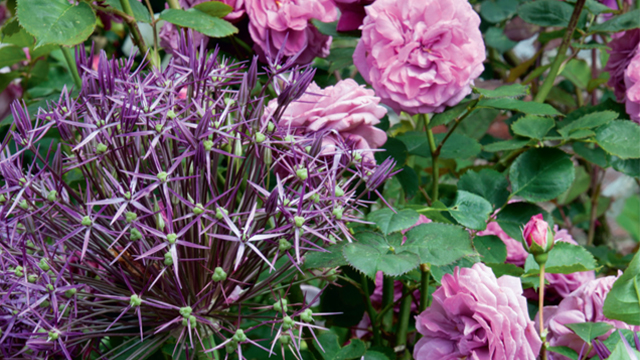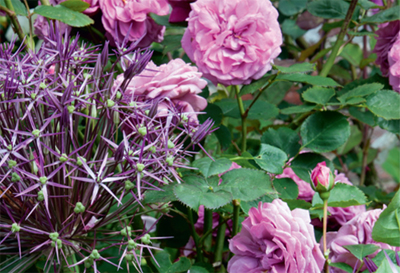The history of Sissinghurst’s roses
Troy Scott Smith explains how he is trying to rebuild the rose garden at Sissinhurst


Of all Sissinghurst's flowers, it was the rose that most captured Vita's imagination. She was particularly fascinated by historical or literary associations and thought it incredibly romantic that the gallica roses that had arrived in Provins, France, from Persia, had been brought back by the Crusaders in 1240.
So it is that roses are central to the Sissinghurst style of planting and typical of its soft abundance, subtlety and romance. Both Vita and Harold felt that Sissinghurst ‘lent itself kindly to their untidy, lavish habit; there was space a plenty, with the walls to frame their exuberance'. Consequently, ‘roses may be found growing in a jungle, sprawling, intertwining, barely tamed and foaming in an unorthodox way'.
Vita and Harold's notes of 1953 state that they grew nearly 200 different ‘old' roses (those that were bred before 1867) at Sissinghurst, including many that are still in the garden today, such as the dark and sumptuous Tuscany-which was also known as the Velvet Rose- Cardinal de Richelieu, Complicata, Camaieux, Charles de Mills and Belle de Crécy. Vita acknowledged that they had their limitations, flowering only once in a gloriously riotous mass in June, but she relished their colours, their scent, form and beauty and felt that their merits far outweighed their faults. In 1937, she wrote: ‘In spite of these drawbacks a collection of old roses gives a great and increasing pleasure.' And again, in 1954, she wrote: ‘There is nothing scrimpy or stingy about them. They have a generosity which is as desirable in plants as in people.' For Vita, the romance of the old roses was everything.
The rose garden originated as a kitchen garden and, among Vita's diaries and notebooks, there are records of rose purchases from Bunyard of Maidstone, Hilda Murrell, Graham Stuart Thomas at Hillings and Constance Spry, among others. The roses are set among herbaceous planting that provides a long season of colour, harmonising with their pinks, reds, purples and creams. The only original York stone path is on the Long Border on the north side, adjacent to the 16th-century wall. The other sides are formed by Powys's 1930s wall, with its apse at the west end, and hedges to the south and the east.

Roses are some of the most important flowers at Sissinghurst
A second main path extends from the raised apse to a statue at the east end, through the turf Rondel. Three other north-south paths combine with this line to divide the garden into 14 beds. Along the minor axes formed by the grid of paths, there are glimpses of the adjacent garden rooms. Vita explained: ‘We have kept the purple roses more or less in a bed to themselves... Let us admit that the purple rose may be an acquired taste, and by purple rose I do not mean a red rose which "dies" badly, anathema to all rosarians...
I mean the truly intentional purple, whether it be the slaty-lilac of Cardinal Richelieu, or the Parmaviolet Tour de Malakov, or Charles de Mills, or Belle de Crécy, or Reine des Violettes, or Hippolyte which by the way does much better in semi-shade, and the moss William Lobb. These, and others, we have assembled in a corner, with an under planting of dark-mauve pansies, Cheiranthus mutabilis, and Allium cyaneum, and the old R. Veilchenblau climbing the wall behind them. If people don't like them, they can turn their backs and look at some-thing else, but I think the loss is theirs.'
Sign up for the Country Life Newsletter
Exquisite houses, the beauty of Nature, and how to get the most from your life, straight to your inbox.
Nowhere else is the character of Vita's planting more apparent than in the Rose Garden; its soft abundance and the colours she most loved are here as evident as ever. In the years since her death, many flowers have been added, making it almost as enchanting before and after the roses bloom. However, today, only 100 of the roses that Vita grew remain. Recently,
I began sourcing as many of the ‘missing' roses as possible, which are now planted. And, later this year, I will visit rose gardens in both France and Germany in search of the remaining ones. I hope that, by next spring, all of Vita's 200 roses will once again be growing at Sissinghurst.
* Visit Sissinghurst at www.nationaltrust.org.uk/sissinghurst-castle
* Follow Country Life magazine on Twitter
Country Life is unlike any other magazine: the only glossy weekly on the newsstand and the only magazine that has been guest-edited by HRH The King not once, but twice. It is a celebration of modern rural life and all its diverse joys and pleasures — that was first published in Queen Victoria's Diamond Jubilee year. Our eclectic mixture of witty and informative content — from the most up-to-date property news and commentary and a coveted glimpse inside some of the UK's best houses and gardens, to gardening, the arts and interior design, written by experts in their field — still cannot be found in print or online, anywhere else.
-
 Five beautiful homes, from a barn conversion to an island treasure, as seen in Country Life
Five beautiful homes, from a barn conversion to an island treasure, as seen in Country LifeOur pick of the best homes to come to the market via Country Life in recent days include a wonderful thatched home in Devon and a charming red-brick house with gardens that run down to the water's edge.
By Toby Keel Published
-
 Shark tanks, crocodile lagoons, laser defences, and a subterranean shooting gallery — nothing is impossible when making the ultimate garage
Shark tanks, crocodile lagoons, laser defences, and a subterranean shooting gallery — nothing is impossible when making the ultimate garageTo collectors, cars are more than just transport — they are works of art. And the buildings used to store them are starting to resemble galleries.
By Adam Hay-Nicholls Published